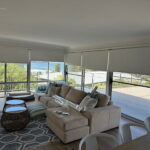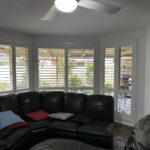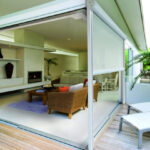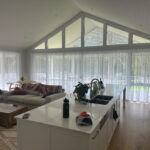Vertical Blind Stacking Options
When choosing vertical blinds, most people focus on the fabric, colour, or blade size — but one design detail that can completely change how your blinds function and look is how they stack. The stack refers to the side (or sides) where the blinds gather when they’re fully open. Choosing the right stacking option affects everything from convenience and access to how much natural light enters your room.
There are three main vertical blind stacking options: left stack, right stack, and split stack (also called centre stack or two-way draw). Each one offers a different aesthetic and functional advantage depending on your room layout, window type, and how you use the space.
In this guide, we’ll explore the differences between these stacking options, explain how they affect daily use, and help you choose the ideal one for your home or business.
Check out our Blinds by Room guide and Blinds by Window guide for expert advice on choosing the perfect window coverings for every space and window style in your home.
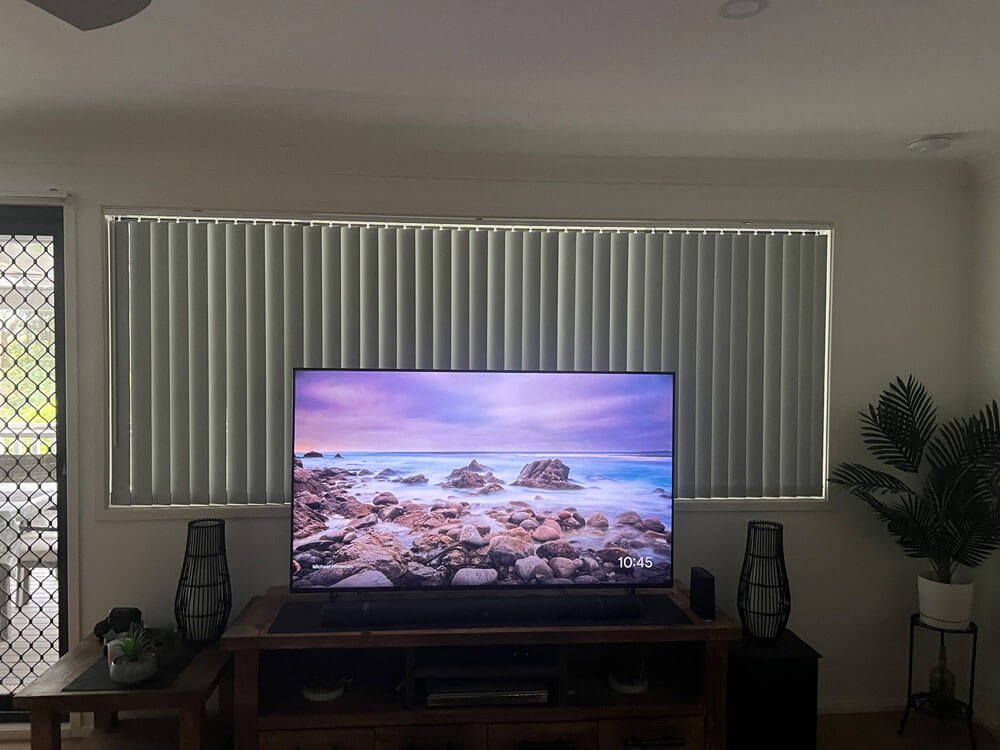
What are vertical blind stacking options?
Vertical blind stacking options describe where the blind blades (also called slats) move when the blinds are opened. Unlike roller or Venetian blinds that move up and down, vertical blinds slide horizontally along a track, stacking neatly on one or both sides.
Each stacking choice has a distinct impact on the room’s look and function:
- Left stack: All slats move and gather on the left side.
- Right stack: All slats move and gather on the right side.
- Split stack (centre stack or two-way draw): The blinds part in the middle, stacking evenly to both the left and right sides.
Selecting the right configuration ensures your blinds work with — not against — your room’s layout, furniture, and natural light.
Left stack vertical blinds
A left stack configuration means all of the vertical blind slats move toward the left side of the window or door when opened. This option is ideal when the main access or handle of your sliding door is on the right, allowing you to easily walk through without obstruction.
Best for:
- Sliding glass doors with handles on the right side.
- Windows where the left side has less furniture or wall space.
- Rooms where a consistent, one-sided design looks more balanced.
Advantages of left stack vertical blinds:
- Keeps the right-hand side clear for easy access or a view.
- Creates a uniform, streamlined look when multiple blinds are installed in a row.
- Perfect for rooms where furniture or fittings (like air conditioners or shelving) make the right side less practical for stacking.
Considerations:
Since all blades gather on one side, the left stack can slightly block part of the view or light from that direction. However, this is generally minimal and can be managed by customising the stack width based on your window size.
Right stack vertical blinds
A right stack means all slats move to the right-hand side when the blinds are drawn open. This is the mirror image of a left stack and is most suitable for rooms or doors where the main handle, traffic flow, or access is on the left.
Best for:
- Sliding or bi-fold doors that open from the left.
- Areas where furniture or decor limits stacking space on the left.
- Large glass panels where consistent alignment enhances aesthetics.
Advantages of right stack vertical blinds:
- Ideal for high-traffic areas leading to patios or balconies, where you need unobstructed access on the left.
- Offers a balanced, symmetrical look when paired with other windows or doors in the same room.
- Works beautifully with right-handed control systems for ease of use.
Considerations:
Like the left stack, the right stack will slightly reduce visibility on the side where the blades gather. This is often a small compromise for the convenience of keeping the main entry point clear and functional.
Split stack (centre stack) vertical blinds
A split stack configuration — also known as a centre stack or two-way draw — is where the vertical blinds open from the centre, with half of the slats moving to the left and half to the right. This creates a symmetrical, curtain-like effect that suits large windows, sliding doors, or statement openings.
Best for:
- Wide sliding or patio doors where even coverage and symmetry are preferred.
- Large picture windows where you want to centre the view.
- Spaces where both sides of the door or window are equally accessible.
Advantages of split stack vertical blinds:
- Creates an elegant, balanced appearance that mimics the look of traditional curtains.
- Allows maximum natural light when open, as the blinds clear both sides of the window.
- Reduces the amount of stacked material on one side, keeping the space looking open and uncluttered.
- Ideal for wide openings, as each side only needs half the space for stacking.
Considerations:
A split stack can require more track hardware and slightly more complex installation, especially for very large spans. It’s best suited for doors or windows that open from the centre or for spaces where balance and symmetry matter most.
Comparing vertical blind stacking options
| Stacking Option | Description | Best For | Advantages | Considerations |
|---|---|---|---|---|
| Left Stack | All slats gather on the left side | Sliding doors with right-side handles | Keeps right side clear, neat uniform look | Blocks part of the view on the left |
| Right Stack | All slats gather on the right side | Sliding doors with left-side handles | Easy access from left, balanced appearance | Slightly reduces view on the right |
| Split Stack | Slats divide evenly to both sides | Large windows or central doors | Elegant, symmetrical, maximises light | Requires more track space and setup |
Each configuration has its advantages, but the choice largely depends on practical factors such as access points, furniture placement, and how you want the blinds to look when open.
How stacking options affect light and space
The stack placement doesn’t just affect how the blinds open — it also influences how light enters your home and how spacious a room feels.
- Single-side stacks (left or right): Ideal for maximising wall space and maintaining consistent alignment across multiple windows. They slightly reduce natural light from one side but offer a streamlined, tidy appearance.
- Split stacks: Let in the most light when open and distribute it evenly. This can make a room feel brighter and more balanced. However, they need enough space on both sides for the slats to stack properly.
If you’re fitting vertical blinds over a wide sliding door or a full wall of glass, a split stack often delivers the best blend of function and style.
Customising your vertical blinds
The beauty of vertical blinds lies in their versatility. Beyond choosing your stacking direction, you can also customise:
- Blade size: 89mm or 127mm options depending on the room size and design preference.
- Material: From textured fabrics to PVC or blockout materials for UV and light control.
- Operation: Manual chain or wand controls, or even motorised systems for added convenience.
- Track colour and finish: To complement your decor and blend with wall tones.
Every aspect can be tailored to match your lifestyle and aesthetic goals — including the stacking direction that best fits your space.
Choosing the right stacking option
To decide which of the vertical blind stacking options suits your home best, consider:
- The door or window layout: Which side opens most often?
- Furniture placement: Which side has more space for stacked blades?
- View and sunlight direction: Which way faces the outdoors or the strongest sunlight?
- Design preference: Do you prefer a clean, one-sided stack or a symmetrical, curtain-style effect?
If your main concern is convenience, match the stack direction to the door handle or main access point. If balance and light are priorities, a split stack might be the perfect solution.
Custom vertical blinds from The Blind Crew
At The Blind Crew, we offer made-to-measure vertical blinds with all stacking options available — left, right, or split. Every blind is crafted to fit your windows perfectly, ensuring smooth operation and a polished finish.
We use high-quality Australian materials built to handle local conditions, with options for blockout fabrics, UV protection, and motorised operation. Whether you’re covering a sliding door, bay window, or sunroom, we’ll help you choose the ideal design, fabric, and stack configuration for your space.
From consultation to installation, The Blind Crew delivers expert service and precision craftsmanship — helping you achieve a stylish, functional finish that complements your home beautifully.
Looking for blinds in your local area? Find your suburb here to see if The Blind Crew services your location.
Please Note: The Blind Crew specialises exclusively in the supply and installation of custom-made blinds, shutters, and awnings.
We do not offer blind cleaning or repair services.
For trusted maintenance options, visit Jim’s Cleaning Blinds Division 131 546 or Amazing Blind Repairs 1300 138 150.
Fast Turnaround – Blinds, Shutters & Outdoor Awnings Installed Quickly
- Roller blinds: Installed within just a few days (pending fabric stock by Australian suppliers)
- Electric Motors: Installed within just a few days (pending Stock)
- Indoor blinds: (vertical, venetian, roman, panel): 7–14 days
- Plantation shutters: 3–4 weeks
- Outdoor blinds & awnings: 3–4 weeks
Key Takeaways
- The Blind Crew offers roller blinds, verticals blinds, venetian blinds, roman blinds, panel blinds, double roller blinds, plus Plantation shutters, curtains including blackout curtains, Sheer curtains, Double curtain rods; outdoor blinds and awnings and smart home automising— all custom made for your home.
Navigation Tip: Click on any coloured work to explore that products or categories - Our exclusive Haven, Solace, and Coastra fabric collections suit a wide range of interiors and coastal conditions.
- We provide free measure and quote, fast turnaround, and expert local installation — with no hidden costs.
- We bring the mobile showroom to your door — so you can see fabrics, colours, and window coverings in your own Central Coast home.
